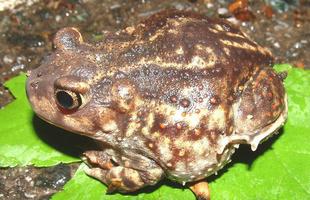 | Back to e-WV
| Back to e-WV
 The West Virginia Encyclopedia
The West Virginia Encyclopedia
 | Back to e-WV
| Back to e-WV
 The West Virginia Encyclopedia
The West Virginia Encyclopedia

West Virginia has 87 known species of amphibians and reptiles, including 34 species of salamanders, three species of toads, 11 species of frogs, 13 species of turtles, six species of lizards, and 20 species of snakes.
Most amphibians have moist glandular skin, and all deposit gelatinous-covered eggs in water or in terrestrial sites such as rotting logs, under rocks, or underground. Their sensitive integument and eggs make them susceptible to pollutants in water and soil, as well as changes in moisture and temperature.
Salamanders are found in ponds, streams, and on wooded hillsides. In West Virginia they range in size from the hellbender, which can be nearly 24 inches in length, to the diminutive four-toed salamander, which is about four inches long. Two species, the West Virginia spring salamander and the Cheat Mountain salamander, are endemic to the Mountain State, occurring only here. The West Virginia spring salamander is known to occur only in General Davis Cave in Greenbrier County, and the Cheat Mountain salamander occurs in the five eastern, mountainous counties of Randolph, Pocahontas, Tucker, Pendleton, and Grant. The Cheat Mountain salamander is the only amphibian in the state on the federal list of threatened and endangered species. No reptiles are listed.
Three species of toads are known to inhabit the state. The American toad and Fowler’s toad are relatively common, but the spadefoot toad is seldom seen because of its secretive nature of remaining underground, only surfacing to mate and deposit eggs during heavy rains. Frogs are found from the lowest elevations to the highest. They range in size from the tiny cricket frog to the bullfrog. Frogs are put into two groups, tree frogs and true frogs. Tree frogs include the common spring peeper and five other species. In addition to the bullfrog, there are four other species of true frogs in West Virginia.
Reptiles (turtles, lizards, and snakes) come in a variety of shapes but all share common characteristics such as epidermal scales and an egg with embryonic membrane. Their skin and eggs allow them to live in more adverse habitats than amphibians. The box turtle is the most terrestrial turtle in the state. The wood turtle (only known to occur in the Eastern Panhandle) is frequently seen on land. Some aquatic species such as the spotted turtle (also only known to occur in the Eastern Panhandle) have limited ranges. Other aquatic species such as the snapping turtle are common throughout the Mountain State.
Lizards resemble salamanders, but unlike salamanders have scales and ear openings. The most common lizards are the fence lizard and the five-lined skink (sometimes locally known as the bluetailed lizard). Lizards range in size from the ground skink (four inches long) to the broadhead skink (up to 12 inches long).
Of the 20 species of snakes known to occur in West Virginia, only two, the timber rattlesnake and the northern copperhead, are venomous. Most species encountered by people are not venomous. There are three species of black snakes in the state, the black racer, black rat snake, and black kingsnake. The most uncommon snake is the pine snake. Only one specimen of this species has been recorded in the state (Monroe County in 1940). In 2008, the timber rattlesnake was designated the state reptile.
State regulations limit the number of reptiles and amphibians that hunters and collectors can take from the wild. For those with valid state fishing permits, the daily creel limit for American bullfrogs and green frogs is 10, with a possession total limit of 20, but it is illegal to possess more than four of any other species of frog or toad. The daily creel limit for snapping turtles and spiny softshells is 10, with a possession limit of 20. Collectors may possess no more than 10 salamanders, with higher limits for bait dealers. Most other turtle species are limited to four, with several other turtle species illegal to possess. No more than four snakes or lizards may be collected. Northern copperheads and timber rattlers are limited to one each, and timber rattlers must be at least 42 inches long, except for those found in houses, outbuildings, or gardens or fields used for agriculture.
There is concern among biologists of an apparent worldwide decline of some amphibian species. West Virginia is not immune from such declines. Recent surveys in known sites for Blanchard’s cricket frog along the Ohio River and for the upland chorus frog in Monroe and Greenbrier counties indicate that the Blanchard’s cricket frog may no longer occur in West Virginia and the upland chorus frog may not be in these southeastern counties. Still, West Virginia has a rich representation of amphibians and reptiles that fit into valuable ecological niches. They represent a major component of our hidden biodiversity.
Based on current Division of Natural Resources regulations, it is illegal to take or possess most native reptiles or amphibians. Exceptions are made for snakes found in personal houses, outbuildings, or gardens. The prohibited list includes the following:
Salamanders
Frogs and Toads
Lizards
Snakes
Turtles
There are exceptions for individuals who have written permission from the DNR Wildlife Resources Chief. In addition, it is legal to take and possess bullfrogs, green frogs, snapping turtles, and eastern spiny softshell turtles, all of which are commonly collected for food consumption.
Visit the West Virginia DNR website to find wildlife regulations, fields guides, posters and more.
Written by Thomas K. Pauley
Green, N. B. & T. K. Pauley. Amphibians & Reptiles in West Virginia. Pittsburgh: University of Pittsburgh Press, 1987.